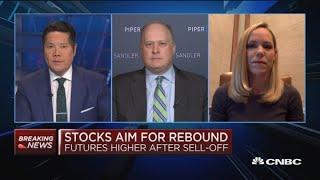Top market watchers on separating fear from the probabilities
Description
Steve Chiavarone of Federated Hermes, Brian Kelly of Brian Kelly Capital, and Peter Boockvar of Bleakley Advisory Group discuss the markets' massive moves in the past week, and whether a rate cut by the Fed and other central banks will move the needle.
Stocks rebounded sharply from their worst week since the financial crisis on Monday, with the Dow Jones Industrial Average posting its best day in more than a decade. Expectations that the Federal Reserve would cut rates drove the gains, which accelerated aggressively into the close.
The Dow closed 1,293.96 points higher, or 5.1%, at 26,703.32. The move on a percentage basis was the Dow’s biggest since March 2009. It was the largest-ever points gain for the 30-stock average.
The S&P 500 climbed 4.6% — its best one-day performance since Dec. 26, 2018 — to close at 3,090.23. The Nasdaq Composite also had its best day since 2018, surging 4.5% to 8,952.16.
Monday’s gains snapped a seven-day losing streak for the Dow.
Apple shares led the Dow higher with a 9.3% jump; Merck and Walmart gained 6.3% and 7.6%, respectively. Utilities, tech, consumer staples and real estate all rose more than 5% to lead the S&P 500 higher.
The major averages were coming off a massive decline from the week before as worries over the coronavirus spreading dented investor sentiment.
“The market has been conditioned to buy on any weakness,” said Keith Buchanan, portfolio manager at GLOBALT. “We’ve grown accustomed to bad days being followed by a few good days in a row.”
The major averages had their worst weekly performance since 2008 last week and entered correction territory, down more than 10% from all-time highs set last month. On Monday, however, the Dow, S&P 500 and Nasdaq all closed out of correction. The Dow and Nasdaq were 9.7% and 9% below their respective record highs. The S&P 500 ended the day 8.9% below its all-time high.
But Peter Cardillo, chief market economist at Spartan Capital Securities, was skeptical the worst was over for the market.
“I wouldn’t put too much into this,” he said, noting longer-dated U.S. Treasurys are still trading near record levels as coronavirus fears persist. “Although I think we’re getting close to putting in a bottom, I still think we need to drop another 2% to 3% to have some sort of capitulation.”
More than 89,000 cases have been confirmed around the world along with more than 3,000 virus-related deaths. Australia, Thailand and the U.S. reported over the weekend their first coronavirus-related deaths. Rhode Island was the first U.S. state on the East Coast to report a coronavirus case.
The number of cases in England rose to 35 after 12 new cases were confirmed on Sunday. Cases in China also reported more than 500 new cases on Saturday. New York Gov. Andrew Cuomo confirmed Sunday night the state’s first positive coronavirus case.
For access to live and exclusive video from CNBC subscribe to CNBC PRO: https://www.cnbc.com/pro/?__source=youtube
» Subscribe to CNBC TV: https://cnb.cx/SubscribeCNBCtelevision
» Subscribe to CNBC: https://cnb.cx/SubscribeCNBC
» Subscribe to CNBC Classic: https://cnb.cx/SubscribeCNBCclassic
Turn to CNBC TV for the latest stock market news and analysis. From market futures to live price updates CNBC is the leader in business news worldwide.
Connect with CNBC News Online
Get the latest news: http://www.cnbc.com/
Follow CNBC on LinkedIn: https://cnb.cx/LinkedInCNBC
Follow CNBC News on Facebook: https://cnb.cx/LikeCNBC
Follow CNBC News on Twitter: https://cnb.cx/FollowCNBC
Follow CNBC News on Instagram: https://cnb.cx/InstagramCNBC
#CNBC
#CNBC TV





















Comments